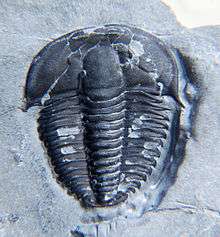Kendallina
Kendallina is a genus of trilobite with an inverted egg-shaped outline, a wide headshield, small eyes, small deflected spines, 12 thorax segments and a small, short tailshield. It lived during the Upper Cambrian in what are today Canada and the United States.
| Kendallina | |
|---|---|
 | |
| Kendallina crassitesta, 18mm | |
| Scientific classification | |
| Kingdom: | |
| Phylum: | |
| Class: | |
| Order: | |
| Superfamily: | Anomocaroidea |
| Family: | Parabolinoididae |
| Genus: | Kendallina Berg, 1953 |
| species | |
| Synonyms | |
|
Kendallia Berg, 1953, non Evermann & Shaw, 1927 (jr. synonym of Hemiculter, a carp) | |
Description
The outline of the exoskeleton Kendallina is inverted egg-shaped, with a wide rectangular headshield (or cephalon) about twice as wide as long. The well-defined central raised area (or glabella), excluding the backward occipital ring, is almost as wide as long, moderately convex, truncate-tapering, with 3 pairs of shallow to obsolete lateral furrows. The occipital ring is well defined. The distance between the glabella and the border (or preglabellar field) is ±¼× as long as the glabella. Kendallina has small eyes, ⅛× as long as the cephalon, which are positioned near the front of the glabella and about half as far out as the glabella is wide. The remaining parts of the cephalon, called fixed and free cheeks (or fixigenae and librigenae) are flat. The fracture lines (or sutures) that in moulting separate the librigenae from the fixigenae are divergent just in front of the eyes, becoming parallel near the border furrow and strongly convergent at the margin. From the back of the eyes the sutures are straight, diverging outward and backward at approximately 45°, cutting the posterior margin well within the inner bend of the spine (or opisthoparian sutures). The articulating middle part of the body (or thorax) has 12 segments. The anteriormost segment gradually narrows into a sideward directed point, while further to the back the segments are rounded with a short, outward deflected spine at back of their outer tips. The small tailshield (or pygidium) is about ⅓× as wide as the cephalon, narrowly transverse about 3× wider than long. Its axis is about the same width as pleural fields to each side, and has up to 3 axial rings and a terminal and almost reaches the margin. Up to 4 pleural segments with obsolete interpleural grooves and shallow pleural furrows. The posterior margin is smooth or has one pair of minute spines. The surface has fine granules or is smooth.[1]
Taxonomy
Kendallina was originally named Kendallia Berg, 1953, but this name was already occupied since Evermann and Shaw bestowed it on a carp in 1927. The replacement name was proposed in the Treatise on Invertebrate Paleontology by Christina Lochman-Balk that same year. Since then, Kendallia Evermann & Shaw, 1927 has been recognized as the junior synonym of Hemiculter.[1]
Distribution
- K. biforota is present in the Upper Cambrian of the United States (Franconian, Conaspis zone, Davis Formation, Elvins Group, Washington County, Missouri, 37.9° N, 90.7° W).[2]
- K. crassitesta has been found in the Upper Cambrian of Canada (Sunwaptan, Parabolinoides subzone and Taenicephalus shumardi subzone, Bison Creek Formation, Alberta, 51.5° N, 116.2° W).[3]
- K. eryon has been identified from the Upper Cambrian of the United States (Clear Creek Section, Open Door Formation, Sublette County, Wyoming, 43.3° N, 109.8° W).[4]
References
- Moore, R.C. (1959). Arthropoda I - Arthropoda General Features, Proarthropoda, Euarthropoda General Features, Trilobitomorpha. Treatise on Invertebrate Paleontology. Part O. Boulder, Colorado/Lawrence, Kansas: Geological Society of America/University of Kansas Press. pp. O272–O273. ISBN 0-8137-3015-5.
- Kurtz, V.E. (1975). "Franconian (Upper Cambrian) trilobite faunas from the Elvins Group of Southeast Missouri". Journal of Paleontology. 49 (6): 1009–1043. cited in Phil Borkow. "Sect. 7, No. 977.42-2, Davis Fm., Elvins Group, MO - Kurtz 1975". fossilworks. Retrieved 2014-02-21.
- Westrop, S.R. (1986). "Trilobites of the Upper Cambrian Sunwaptan Stage, southern Canadian Rocky Mountains, Alberta". Palaeontographica Canadiana. 3: 1–179. cited in Shanan Peters. "Parabolinoides subzone assemblage". fossilworks. Retrieved 2014-02-21.
- Lochman, C.; Hu, C.H. (1960). "Upper Cambrian faunas from the northwest Wind River Mountains, Wyoming. Part 1". Journal of Paleontology. 34 (5): 793–834. cited in Phil Borkow. "Horizon OC6, Clear Creek Sect., Open Door Fm., WY - Lochman and Hu 1960". fossilworks. Retrieved 2014-02-21.